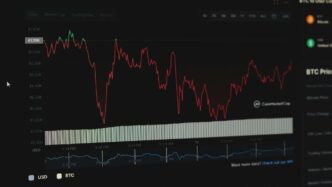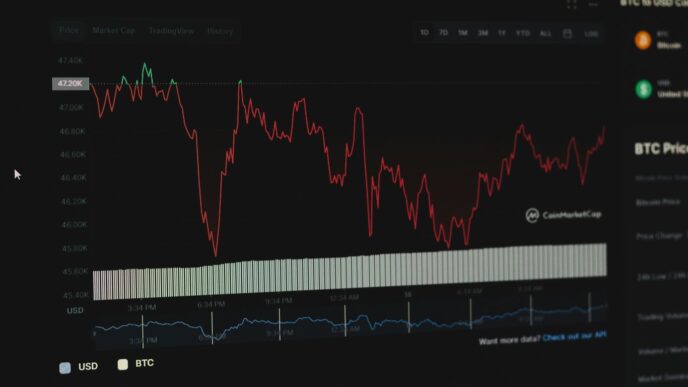This article looks at what Bloomberg is reporting about Asian markets. We’ll cover how these markets are doing, what’s driving their growth, and where investors might find good opportunities. It’s a look at the economic trends and investment ideas coming out of the region, especially when compared to global markets. We’ll also touch on the risks involved and how to approach investing in these dynamic areas.
Key Takeaways
- Asian markets are showing strength despite global economic worries, partly because companies are making a lot of money at home and the tech sector looks promising. Investors are also looking beyond just US assets.
- There are good chances to invest in things like China’s high-yield bonds and utility companies, as well as India’s growing economy and its bonds. Looking at different emerging markets in Asia can also spread out risk.
- When investing, it’s smart to think about both safer investment-grade options and riskier frontier markets. Using bonds in local currencies and ways to protect against currency changes can help. Also, special financial products might offer different ways to invest.
- Companies in Asia are buying back their own stock, which is good for shareholders. China’s tech industry is growing in a way that’s separate from Western tech trends, and how people spend their money is changing the market.
- Investors need to be aware of potential problems like currency swings, changes in interest rates, political issues, and worries about consumer spending, especially in China’s property market.
Asian Markets Resilience Amid Global Headwinds
It’s been a bit of a wild ride for global markets lately, hasn’t it? You’ve got all these trade worries and political stuff happening, making everyone a little nervous. But here in Asia, things are looking surprisingly steady. A big reason for this is that many companies here are really leaning on their sales within their own countries. They aren’t as dependent on what’s happening overseas, which is a pretty smart move when the world feels a bit shaky.
Domestic Revenue Dominance Driving Growth
Think about it – when a company’s main customers are right in its backyard, it’s less affected by what happens in, say, the US or Europe. We’re seeing this play out across the region. For example, in Indonesia, about 93% of revenue for listed companies comes from within the country. India isn’t far behind at 77%, and the Philippines is at 75%. Even in China, a huge chunk of revenue, nearly 85%, is generated domestically. This strong local demand acts like a cushion against international turbulence. It means that even if global trade gets complicated, these businesses can keep going because their home markets are still buying.
Robust Technology Sectors and AI Potential
Beyond just domestic sales, Asia’s tech scene is also a big story. Companies are showing real strength, especially in areas like advanced technology and artificial intelligence. It’s not just about making things anymore; it’s about innovation. This tech growth is happening even when the broader economy might be slowing down. What’s really interesting is that the AI cycle in China, for instance, seems to be moving on its own track, not really tied to what’s happening in the West. This kind of uncorrelated growth is exactly what investors look for when trying to spread out their risks. Plus, when you look at valuations, some of the top tech companies in Asia are trading at much lower prices compared to their counterparts on the Nasdaq. That could be a good sign for future growth.
Tempered Investment Sentiment Towards US Assets
Another factor helping Asian markets is a bit of a shift in how investors are looking at US assets. There’s a growing sense that maybe the US isn’t the only game in town, or the automatic best choice. This
Unlocking High-Growth Opportunities in Asia
Asia’s emerging markets are really starting to catch the eye of global investors looking for growth and a bit of diversification. It’s not just one thing, either. We’re seeing chances pop up in different asset classes, sectors, and even across various countries.
China’s High-Yield Bonds and Undervalued Utilities
China’s high-yield bond market is showing some interesting potential, especially in sectors like utilities. Think about gas companies, for example. They tend to have steady demand from consumers, which makes them a more stable bet for investors even when the broader economy is a bit shaky. Some of these state-owned enterprises and utility firms are actually trading at prices that seem pretty low, considering their consistent performance. It’s a good example of how looking beyond the headlines can reveal solid opportunities. We’re also seeing convertible bonds from big tech companies in Hong Kong, which can give you a piece of the growth without buying the stock directly. It’s a smart way to get exposure.
India’s Economic Momentum and Bond Market Inclusions
India is another bright spot. The country’s economy has been building serious momentum, and its recent inclusion in a major global bond index is a big deal. This move is drawing in more foreign investment and making Indian government bonds more liquid, which is always good news for investors. Plus, with non-bank financial companies issuing more debt to diversify their funding, there are more options appearing in India’s high-yield credit space. It’s all part of a bigger picture of economic expansion that’s pretty compelling.
Diversification Across Emerging Markets
Beyond China and India, there’s a whole range of other emerging markets in Asia that are worth a look. Investors are starting to broaden their horizons, adding more of the Pacific region to their portfolios. This means looking at countries that might have been overlooked before, which can offer a more diverse risk profile and a wider array of investment possibilities. It’s about spreading your bets, really. For instance, some of the high-yield assets in frontier markets like Sri Lanka and Pakistan are also looking attractively priced right now. It’s a complex region, for sure, but the potential rewards for those willing to do their homework are significant. You can get daily market briefings on these trends from The Asia Trade.
Investment Strategies for Asian Markets
When looking at Asian markets, it’s not just about picking stocks. There are a few ways to approach this, depending on what you’re after. We’re talking about different types of bonds, how to handle currency swings, and even some more complex financial tools.
Navigating Investment-Grade and Frontier Markets
Asia’s bond market is pretty varied. A lot of it is considered ‘investment-grade,’ meaning it’s seen as less risky. Right now, the difference in yield between these bonds and, say, U.S. Treasuries is pretty small, historically speaking. Many investors are holding onto short-term debt, just waiting to see what happens with U.S. interest rates. If U.S. rates start to drop, people might feel more comfortable buying longer-term bonds in Asia.
On the flip side, there are ‘frontier markets.’ These can be riskier, but they often offer higher potential returns. Think about high-yield bonds in places like Sri Lanka or Pakistan, or even some Chinese credit that looks cheap right now. Even though China’s economy is changing, some companies there are still set to do well. We’re also seeing investors look beyond the usual spots, adding more countries from the Pacific region to their portfolios. This means more countries and a wider spread of risks and opportunities.
Leveraging Local Currency Bonds and Hedging
With the U.S. possibly cutting interest rates, bonds denominated in Asian currencies are becoming more attractive. This is especially true if you can lock in a good exchange rate, which helps if you’re worried about currency fluctuations. Even though the actual interest you earn on Asian government bonds might still be lower than on U.S. Treasuries, if the U.S. Federal Reserve cuts rates, Asian central banks might do the same. This could make local currency bonds a really good bet for the next little while.
It’s important to think about currency risk, though. If U.S. interest rates change, it can cause Asian currencies to move around quite a bit. To protect against this, investors often use something called hedging. This can involve using financial contracts, like currency swaps, to shield your investment from sudden drops in currency value. This is particularly important for currencies like the Japanese yen, Korean won, Thai baht, and Malaysian ringgit, which can be quite sensitive to U.S. rate changes.
Structured Products and Derivative Access
For those looking for more sophisticated ways to invest, structured products are becoming more common in Asia. These can include things like total return swaps, which let you get into markets like China without having to set up a direct presence there. You can also find things like callable credit-linked notes. Asian investors are using these to try and get a bit more return while still managing the risks involved in different types of investments, from bonds to stocks.
Here’s a quick look at some of the risks and opportunities:
- Investment-Grade Bonds: Spreads are tight, driven by U.S. Treasury movements. Investors are waiting for U.S. rate cuts to extend duration.
- Frontier Markets: High-yield assets in places like Sri Lanka, Pakistan, and China offer potential. Chinese utilities are seen as undervalued.
- Local Currency Bonds: Appeal is growing due to potential FX hedging benefits and anticipated Asian central bank easing.
- Structured Products: Tools like total return swaps offer access to markets and yield enhancement.
It’s a complex landscape, for sure. You’ve got to keep an eye on interest rate changes, especially from the U.S., and how that affects currency values. Geopolitical events can also add a layer of uncertainty. And in places like China, consumer confidence and the property market are still things to watch, even though the property sector’s direct impact on the broader Asian credit market has lessened.
Key Economic Trends Shaping Asian Markets
Asian markets are showing some interesting shifts right now, and it’s not just about what’s happening overseas. A lot of what’s driving growth comes from right within these countries. Companies are increasingly looking inward for their revenue, which is a big change from relying heavily on exports. This domestic focus helps cushion them from global trade spats and other international issues.
Corporate Share Buy-Backs and Investor Rewards
One trend that’s really catching investors’ eyes is the rise in corporate share buy-backs across Asia. Companies are using their profits to buy back their own stock, which can boost earnings per share and signal confidence in their future. It’s a way for them to return value directly to shareholders. We’re seeing this happen quite a bit, especially in places like China, where nearly 85% of company revenue is generated domestically. This practice is becoming a pretty standard way for businesses to reward investors.
China’s Technology Cycle and Uncorrelated Growth
China’s tech sector is always a hot topic, and it’s going through its own cycle. While global tech might be facing some headwinds, certain segments in China are showing growth that doesn’t seem directly tied to the rest of the market. Think about companies focused on domestic consumption or specific industrial applications. There’s also potential in areas like artificial intelligence, which could drive future growth. It’s about finding those pockets of innovation that are performing well, regardless of broader market sentiment. Some investors are looking at convertible bonds from major tech firms in Hong Kong as a way to get in on this growth without buying stocks directly.
Shifting Consumer Behavior and Spending Patterns
Consumer habits are definitely changing across Asia, and this is having a real impact on markets. With more income and evolving preferences, people are spending differently. This is particularly noticeable in China, where the property market has had its ups and downs. While the property sector’s direct impact on the broader Asian credit market has lessened, consumer confidence remains a key indicator. Restoring that confidence is seen as vital for stimulating demand. Policy changes are happening, but it’s really about how people feel about the economy that will drive spending and, in turn, market performance. This shift means companies that can adapt to new consumer demands are likely to do well.
Navigating Risks in Asian Emerging Markets

Alright, so diving into Asian emerging markets can feel like a bit of a tightrope walk sometimes, right? There are definitely some bumps in the road you need to be aware of. It’s not all smooth sailing, and ignoring these potential pitfalls could really mess with your returns.
One of the big things is how U.S. interest rates shake things up. When the Fed makes a move, it sends ripples across Asia. If they cut rates too fast, for instance, currency values can get pretty wild, and that affects how much your investments are worth back home. Using currency hedging tools is super important here, especially for currencies like the Japanese yen or the South Korean won, which tend to swing with U.S. rate changes. It’s like having an umbrella ready before the rain starts.
Then there’s the whole geopolitical scene. Things between the U.S. and China, for example, can create a lot of uncertainty. Plus, upcoming elections in the U.S. could mean policy shifts that investors are watching closely. It’s a lot to keep track of.
And let’s not forget about consumer confidence, especially in China. The property market there has been a bit shaky for a while, and that still casts a shadow. Even though it’s a smaller piece of the overall market now, it tells us something about how people are feeling about the economy. Getting that consumer sentiment back up is key for a real recovery, and it’s not just about tweaking mortgage payments. People need to feel good about spending.
Here’s a quick rundown of what to watch:
- FX Volatility: Keep an eye on currency swings, particularly those tied to U.S. rate decisions. Hedging can help smooth things out.
- Geopolitical Uncertainty: Stay informed about political developments that could impact market sentiment.
- Consumer Confidence: Monitor how consumers are feeling, as this directly influences economic activity, especially in China.
It’s a complex picture, but by staying aware of these factors, you can make more informed decisions. Remember, emerging markets are dynamic, and staying updated on economic indicators is a good start.
Bloomberg’s Perspective on Asian Market Dynamics
Bloomberg’s recent discussions, particularly from events like the APAC Sell-Side Forum, offer a clear lens on what’s happening in Asian markets. It’s not just about the numbers; it’s about understanding the forces at play. They’ve been looking closely at how Asian companies stack up against their Western counterparts, especially in the tech space. For instance, a comparison of top tech firms in Asia-Pacific versus those on the Nasdaq showed Asian companies trading at a significantly lower valuation. Think a price-to-earnings ratio of around 17 times for Asian tech giants compared to 32 times for their Nasdaq peers, based on estimates from around August 2025. That’s a big difference, suggesting potential value for investors willing to look beyond the usual suspects.
Insights from the APAC Sell-Side Forum
The APAC Sell-Side Forum has been a hotbed for discussions about the region’s economic pulse. A key takeaway is the shift in how Chinese companies are treating their shareholders. For years, it seemed like companies were diluting shareholder value, but that’s changing. We’re seeing more share buy-backs, which is a positive sign for investors. This move towards rewarding shareholders, especially amid slower economic growth in China, could really change the game. It’s a signal that companies are adapting to investor expectations.
The Asia Trade: Daily Market Briefings
Bloomberg’s daily market briefings provide a constant stream of information for those tracking Asian markets. They highlight how domestic revenue is becoming a bigger driver for many Asian economies. Countries like Indonesia, for example, see nearly all their listed companies generating revenue from within their own borders. India and the Philippines are also showing strong domestic revenue generation. This reliance on local demand makes these markets less susceptible to external shocks, like tariffs or global trade disputes. It’s a different kind of resilience than we often see in more export-dependent economies.
Valuation Comparisons: Asia vs. Nasdaq Tech Firms
When you look at the tech sector, the valuation gap between Asia and the Nasdaq is pretty striking. Companies like Taiwan Semiconductor Manufacturing, Tencent, Samsung, Alibaba, and PDD are trading at much lower multiples than their US counterparts. This isn’t just about being cheaper; it’s also about the unique growth story in Asia, particularly with the AI cycle. Bloomberg points out that China’s AI development seems to be on a path that’s quite separate from what’s happening in the West. This uncorrelated growth offers a different kind of opportunity for investors looking to diversify their tech exposure beyond the crowded US market.
Wrapping Up: What’s Next for Asian Markets?
So, looking at everything, it seems like Asian markets are doing pretty well, even with all the global stuff going on. Companies are making more money at home, and tech is a big deal. While there are always things to watch out for, like currency changes or political news, the general vibe is that there are good chances for investors. It’s not just one or two countries either; places like China and India are showing strong signs, and even smaller markets are starting to get more attention. Keep an eye on this region, because it looks like it’s got some serious momentum going forward.
Frequently Asked Questions
Why are Asian markets doing well even when other parts of the world are facing problems?
Asian markets are showing strength because many companies in the region make most of their money from customers within their own countries. Plus, their technology companies are doing great, especially in areas like artificial intelligence. Investors are also starting to look at Asian markets more because they might be finding U.S. investments a bit too expensive or risky right now.
What are some good investment opportunities in Asia right now?
Some interesting areas include Chinese bonds that offer higher interest payments, especially from utility companies that people always need. India is also a strong choice because its economy is growing fast, and its bonds are becoming easier for foreign investors to buy. It’s smart to spread your money across different countries and types of investments in Asia.
How can I invest in Asian markets safely?
You can invest in different types of bonds, like those considered safe (investment-grade) or those in newer, developing markets (frontier markets). It’s also a good idea to invest in bonds that are in the local Asian currencies, and you might want to use tools to protect yourself from changes in currency values. Some special investment products can also help you get better returns while managing risks.
What are the main economic trends happening in Asia that investors should know about?
Companies in Asia are increasingly buying back their own stock, which is good for shareholders. Also, China’s technology sector, especially in AI, is growing in a way that’s different from the West, offering unique chances. People in Asia are also changing how and what they buy, which affects businesses and investments.
What are the biggest risks when investing in Asian emerging markets?
One big risk is that currency values can change quickly, especially if interest rates in the U.S. go up or down a lot. Political situations and uncertainty about government rules can also make things tricky. Lastly, people’s confidence in the economy, particularly in areas like housing, can affect how well businesses do.
What is Bloomberg’s view on the Asian market?
Bloomberg provides regular updates and analysis on Asian markets. They highlight insights from industry experts and offer daily market briefings. They also compare how Asian tech companies are valued compared to those in the U.S., showing that Asian tech stocks might be a better deal right now.














